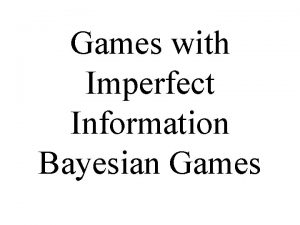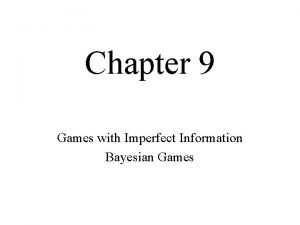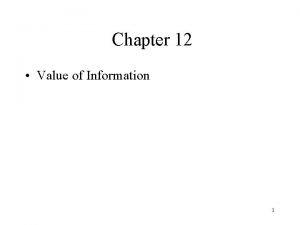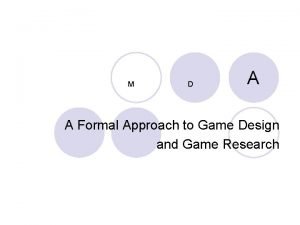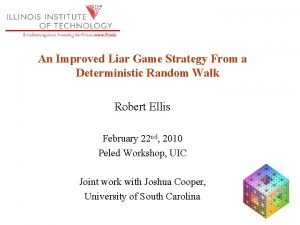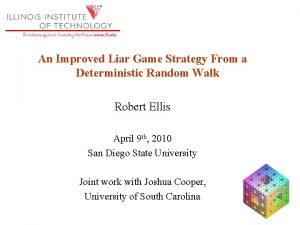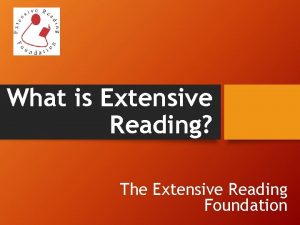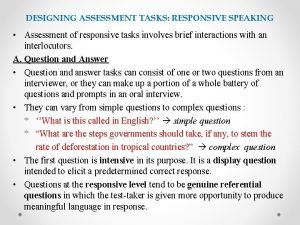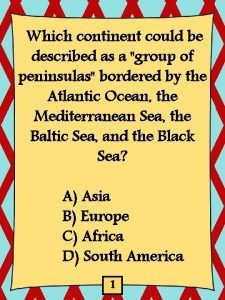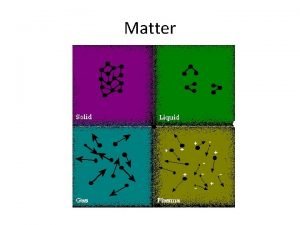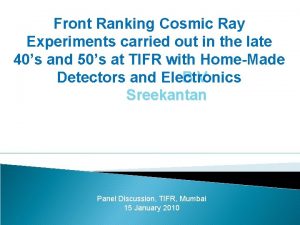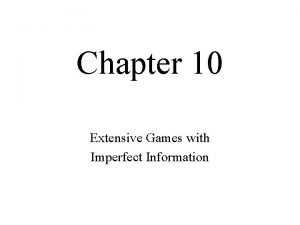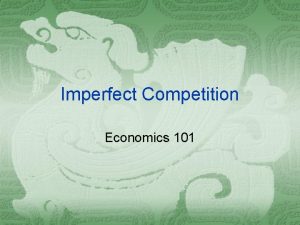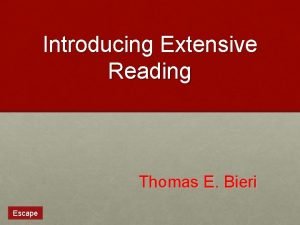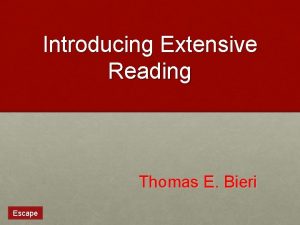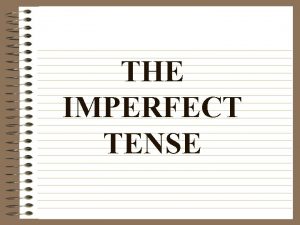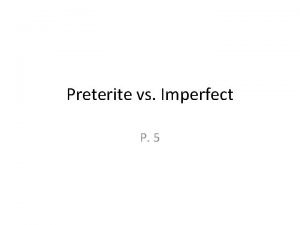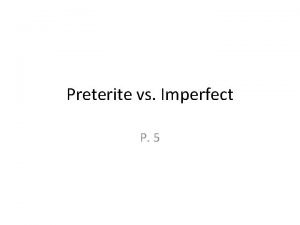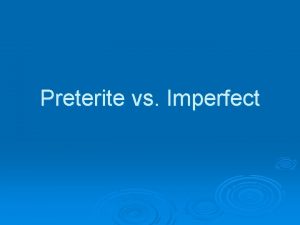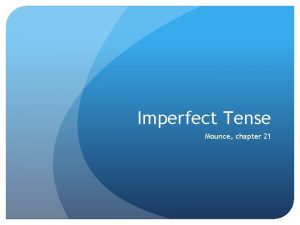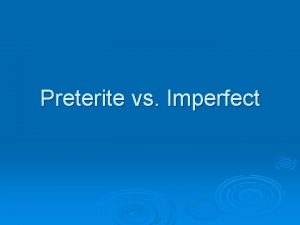Extensive Game with Imperfect Information Part I Strategy


































- Slides: 34

Extensive Game with Imperfect Information Part I: Strategy and Nash equilibrium

Adding new features to extensive games: n A player does not know actions taken earlier n non-observable actions taken by other players The player has imperfect recall--e. g. absent minded driver The “type” of a player is unknown to others (nature’s choice is nonobservable to other players)

Player 1’s actions are nonobservable to Player 2 1 L R M 2 2, 2 2 L R 3, 1 0, 0 R L 0, 2 1, 1

Imperfect recall: Absent minded driver

Nature’s choice is unknown to third party 1, 1 0, -1 -2, -1 hire 1, 2 No hire 2 MBA No MBA hire No hire 2 0, -3 1/2 high c 1/2 low 2 No hire 0, 0 hire -2, 2 MBA 1 No MBA 2 No hire 0, 0

Extensive game with imperfect information and chances n Definition: An extensive game <N, H, P, fc, (Ti), (ui)> consists of n a set of players N n a set of sequences H n a function (the player function P) that assigns either a player or "chance" to every non-terminal history n A function fc that associates with every history h for which P(h)=c a probability distribution fc(. |h) on A(h), where each such probability distribution is independent of every other such distribution. n For each player i, Ti is an information partition and I i (an element of Ti) is an information set of player i. n For each i, a utility function ui.

Strategies n n DEFINITION: A (pure) strategy of player i in an extensive game is a function that assigns to each of i's information sets Ii an action in A(Ii) (the set of actions available to player i at the information set Ii). DEFINITION: A mixed strategy of player i in an extensive game is a probability distribution over the set of player i’s pure strategies.

Behavioral strategy n DEFINITION. A behavioral strategy of player i in an extensive game is a function that assigns to each of i's information sets Ii a probability distribution over the actions in A(Ii), with the property that each probability distribution is independent of every other distribution.

Mixed strategy and Behavioral strategy: an example (L, l) (L, r) ½ ½ (R, l) (R, r) 0 0 β 1(φ)(L)=1; β 1(φ)(R)=0; β 1({(L, A), (L, B)})(l)=1/2; β 1({(L, A), (L, B)})(r)=1/2

non-equivalence between behavioral and mixed strategy amid imperfect recall n n Mixed strategy choosing LL with probability ½ and RR with ½. The outcome is the probability distribution (1/2, 0, 0, 1/2) over the terminal histories. This outcome cannot be achieved by any behavioral strategy.

Equivalence between behavioral and mixed strategy amid perfect recall n Proposition. For any mixed strategy of a player in a finite extensive game with perfect recall there is an outcome-equivalent behavioral strategy.

Nash equilibrium n n DEFINITION: The Nash equilibrium in mixed strategies is a profile σ* of mixed strategies so that for each player i, ui(O(σ*-i, σ*i))≥ ui(O(σ*-i, σi)) for every σi of player i. A Nash equilibrium in behavioral strategies is defined analogously.

Part II: Belief and Sequential Equilibrium

A motivating example 1 L Strategic game L R M 2 2, 2 2 L R 3, 1 0, 2 R L 0, 2 1, 1 R L 2, 2 M 3, 1 0, 2 R 0, 2 1, 1

The importance of offequilibrium path beliefs n n (L, R) is a Nash equilibrium According to the profile, 2’s information set being L reached is a zero probability event. Hence, no restriction to 2’s belief about which history he is in. 2’s choosing R is optimal if he 2, 2 assigns probability of at least ½ to M; L is optimal if he assigns probability of at least ½ to L. Bayes’ rule does not help to determine the belief 1 R M 2 L 3, 1 2 R 0, 2 L 0, 2 R 1, 1

belief n n n From now on, we will restrict our attention to games with perfect recall. Thus a sensible equilibrium concept should consist of two components: strategy profile and belief system. For extensive games with imperfect information, when a player has the turn to move in a non-singleton information set, his optimal action depends on the belief he has about which history he is actually in. DEFINITION. A belief system μ in an extensive game is a function that assigns to each information set a probability distribution over the histories in that information set. DEFINITION. An assessment in an extensive game is a pair (β, μ) consisting of a profile of behavioral strategies and a belief system.

Sequential rationality and consistency n It is reasonable to require that n Sequential rationality. Each player's strategy is optimal whenever she has to move, given her belief and the other players' strategies. n Consistency of beliefs with strategies (CBS). Each player's belief is consistent with the strategy profile, i. e. , Bayes’ rule should be used as long as it is applicable.

Perfect Bayesian equilibrium n Definition: An assessment (β, μ) is a perfect Bayesian equilibrium (PBE) (a. k. a. weak sequential equilibrium) if it satisfies both sequential rationality and CBS. n n n Hence, no restrictions at all on beliefs at zeroprobability information set In EGPI, the strategy profile in any PBE is a SPE The strategy profile in any PBE is a Nash equilibrium

Sequential equilibrium n n n Definition. An assessment (β, μ) is consistent if there is a sequence ((βn, μn))n=1, … of assessments that converge to (β, μ) and has the properties that each βn is completely mixed and each μn is derived from using Bayes’ rule. Remark: Consistency implies CBS studied earlier Definition. An assessment is a sequential equilibrium of an extensive game if it is sequentially rational and consistent. n Sequential equilibrium implies PBE n Less easier to use than PBE (need to consider the sequence ((βn, μn))n=1, … )

Back to the motivating example n n The assessment (β, μ) in which β 1=L, β 2=R and μ({M, R})(M)= for any (0, 1) is consistent Assessment (βε, με) with the following properties n n n βε 1 = (1 -ε, ε, (1 - )ε) βε 2 = (ε, 1 - ε) με ({M, R})(M)= for all ε As ε→ 0, (βε, με)→ (β, μ) For ≥ 1/2, this assessment is also sequentially rational. 1 L 2, 2 R M L 3, 1 2 2 R L R 0, 2 1, 1

Two similar games Game 1 has a sequential equilibrium in which both 1 and 2 play L 1 L Game 2 does not support such an equilibrium 1 C L R M 2 3, 3 Game 1 L 0, 1 2 2 R 0, 0 R M L 1, 0 3, 3 2 L R 0, 1 0, 0 1, 0 5, 1 R 5, 1 Game 2

Structural consistency n n n Definition. The belief system in an extensive game is structurally consistent if for each information set I there is a strategic profile with the properties that I is reached with positive probability under and is derived from using Bayes’ rule. Remark: Note that different strategy profiles may be needed to justify the beliefs at different information sets. Remark: There is no straightforward relationship between consistency and structural consistency. (β, μ) being consistent is neither sufficient nor necessary for μ to be structurally consistent.

Signaling games n n n A signaling game is an extensive game with the following simple form. Two players, a “sender’ and a “receiver. ” The sender knows the value of an uncertain parameter and then chooses an action m (message) The receiver observes the message (but not the value of ) and takes an action a. Each player’s payoff depends upon the value of , the message m, and the action a taken by the receiver.

Signaling games n Two types n n Signals are (directly) costly Signals are directly not costly – cheap talk game

Spence’s education game n n n Players: worker (1) and firm (2) 1 has two types: high ability H with probability p H and low ability L with probability p L. The two types of worker choose education level e H and e L (messages). The firm also choose a wage w equal to the expectation of the ability The worker’s payoff is w – e/

Pooling equilibrium n n n e H = e L = e* L p. H ( H - L) w* = p. H H + p. L L Belief: he who chooses a different e is thought with probability one as a low type Then no type will find it beneficial to deviate. Hence, a continuum of perfect Bayesian equilibria

Separating equilibrium n n n e L= 0 H ( H - L) ≥ e H ≥ L ( H - L) w H = H and w L = L Belief: he who chooses a different e is thought with probability one as a low type Again, a continuum of perfect Bayesian equilibria Remark: all these (pooling and separating) perfect Bayesian equilibria are sequential equilibria as well.

When does signaling work? n n The signal is costly Single crossing condition holds (i. e. , signal is more costly for the low-type than for the hightype)

Refinement of sequential equilibrium n n There are too many sequential equilibria in the education game. Are some more appealing than others? Cho-Kreps intuitive criterion n A refinement of sequential equilibrium —not every sequential equilibrium satisfies this criterion

An example where a sequential equilibrium is unreasonable n n n Two sequential equilibria with outcomes: (R, R) and (L, L), respectively (L, L) is supported by belief that, in case 2’s information set is reached, with high probability 1 chose M. If 2’s information set is reached, 2 may think “since M is strictly dominated by L, it is not rational for 1 to choose M and hence 1 must have chosen R. ” 1 L 2, 2 R M L 1, 3 2 2 R 0, 0 L 0, 0 R 5, 1

Beer or Quiche 1, 1 1, 0 N F Q 1 B N 3, 1 3, 0 2 0. 9 strong Q 1 weak 2 F 0, 0 F N 0. 1 c 0, 1 B N F 1, 0 1, 1

Why the second equilibrium is not reasonable? n n n If player 1 is weak she should realize that the choice for B is worse for her than following the equilibrium, whatever the response of player 2. If player 1 is strong and if player 2 correctly concludes from player 1 choosing B that she is strong and hence chooses N, then player 1 is indeed better than she is in the equilibrium. Hence player 2’s belief is unreasonable and the equilibrium is not appealing under scrutiny. 1, 1 1, 0 N F Q 1 B 3, 0 2 0. 9 c strong F 3, 1 0, 0 F N 0. 1 weak 2 N 0, 1 Q 1 B N F 1, 0 1, 1

Spence’s education game n n n All the pooling equilibria are eliminated by the Cho-Kreps intuitive criterion. Let e satisfy w* – e*/ L > H – e/ L and w* – e*/ H > H – e/ L (such a value of e clearly exists. ) If a high type work deviates and chooses e and is correctly viewed as a good type, then she is better off than under the pooling equilibrium If a low type work deviates and successfully convinces the firm that she is a high type, still she is worse off than under the pooling equilibrium. Hence, according to the intuitive criterion, the firm’s belief upon such a deviation should construe that the deviator is a high type rather than a low type. The pooling equilibrium break down!

Spence’s education game n n n Only one separating equilibrium survives the Cho. Kreps Intuitive criterion, namely: e L = 0 and e H = L ( H - L) Why a separating equilibrium is killed where e L = 0 and e H > L ( H - L)? A high type worker after choosing an e slightly smaller will benefit from it if she is correctly construed as a high type. A low type worker cannot benefit from it however. Hence, this separating equilibrium does not survive Cho-Kreps intuitive criterion.
 Extensive games with imperfect information
Extensive games with imperfect information Incomplete information vs imperfect information
Incomplete information vs imperfect information Imperfect vs incomplete information
Imperfect vs incomplete information Expected value of imperfect information
Expected value of imperfect information Game theory pirate game
Game theory pirate game The farming game instructions pdf
The farming game instructions pdf A formal approach to game design and game research
A formal approach to game design and game research Game lab game theory
Game lab game theory Liar game game theory
Liar game game theory Liar game game theory
Liar game game theory The extensive reading foundation
The extensive reading foundation Extensive and intensive properties in thermodynamics
Extensive and intensive properties in thermodynamics Fractional distillation of alcohol
Fractional distillation of alcohol Extensive network data storage (nds) คือ
Extensive network data storage (nds) คือ Intensive and extensive verbs
Intensive and extensive verbs Extensive vs intensive green roof
Extensive vs intensive green roof Intensive reading and extensive reading
Intensive reading and extensive reading What is intensive in chemistry
What is intensive in chemistry What is intensive speaking
What is intensive speaking Ambitious vocabulary
Ambitious vocabulary Organic agriculture definition ap human geography
Organic agriculture definition ap human geography Solubility is intensive or extensive
Solubility is intensive or extensive A poem skimming scanning extensive intensive
A poem skimming scanning extensive intensive Interactive speaking assessment
Interactive speaking assessment Chapter 11 business and technology
Chapter 11 business and technology Which letter represents the danube river?
Which letter represents the danube river? Culture system with low intensity
Culture system with low intensity Extensive
Extensive Extensive
Extensive Extensive property
Extensive property Real definition of extensive reading
Real definition of extensive reading Gm counter
Gm counter How to develop reading skills in students
How to develop reading skills in students Intensive or extensive
Intensive or extensive Addition symbol
Addition symbol

